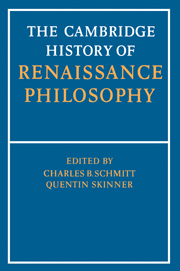Book contents
- Frontmatter
- Introduction
- PART 1 THE INTELLECTUAL CONTEXT
- PART 2 PHILOSOPHY AND ITS PARTS
- 6 Logic and language: Traditional logic
- 7 Logic and language: Humanistic logic
- 8 Natural philosophy: Traditional natural philosophy
- 9 Natural philosophy: The new Philosophy of nature
- 10 Natural philosophy: Astrology and magic
- 11 Moral philosophy
- 12 Political philosophy
- 13 Psychology: The concept of psychology
- 14 Psychology: The organic soul
- 15 Psychology: The intellective soul
- 16 Metaphysics
- 17 Problems of knowledge and action: Fate, fortune, providence and human freedom
- 18 Problems of knowledge and action: Theories of knowledge
- 19 Problems of knowledge and action: Epistemology of the sciences
- 20 Philosophy and humanistic disciplines: Rhetoric and poetics
- 21 Philosophy and humanistic disciplines: The theory of history
- PART 3 SUPPLEMENTARY MATERIAL
- Biobibliographies
- Bibliography
- Index nominun
- Index rerum
- References
8 - Natural philosophy: Traditional natural philosophy
from PART 2 - PHILOSOPHY AND ITS PARTS
Published online by Cambridge University Press: 28 March 2008
- Frontmatter
- Introduction
- PART 1 THE INTELLECTUAL CONTEXT
- PART 2 PHILOSOPHY AND ITS PARTS
- 6 Logic and language: Traditional logic
- 7 Logic and language: Humanistic logic
- 8 Natural philosophy: Traditional natural philosophy
- 9 Natural philosophy: The new Philosophy of nature
- 10 Natural philosophy: Astrology and magic
- 11 Moral philosophy
- 12 Political philosophy
- 13 Psychology: The concept of psychology
- 14 Psychology: The organic soul
- 15 Psychology: The intellective soul
- 16 Metaphysics
- 17 Problems of knowledge and action: Fate, fortune, providence and human freedom
- 18 Problems of knowledge and action: Theories of knowledge
- 19 Problems of knowledge and action: Epistemology of the sciences
- 20 Philosophy and humanistic disciplines: Rhetoric and poetics
- 21 Philosophy and humanistic disciplines: The theory of history
- PART 3 SUPPLEMENTARY MATERIAL
- Biobibliographies
- Bibliography
- Index nominun
- Index rerum
- References
Summary
The natural philosophy of the Renaissance was far from being a homogeneous body of knowledge uniformly accepted and taught in the universities. As one might expect during a rebirth of learning, new views of nature and of man's place in nature took their place alongside those of classical antiquity then being rediscovered and explored for a wisdom long lost. Yet a surprising amount of energy was focused on what might be termed ‘traditional natural philosophy’, i.e., a philosophy of nature hallowed by tradition in the Latin West from the twelfth century onwards and constituting a major part of university studies. In essence this was an Aristotelian philosophy, for the texts that were commented on were those of the Lyceum, but it also contained a considerable accretion of Neoplatonic elements as well as the developments of Islamic, Jewish and Christian commentators. The diversity of sources from which it sprang and the variety of situations in which its teachings took root argue against its ever having been a monolithic system of thought. Indeed, the tradition it embodied was complex, hardly capable of being characterised in simple terms. More, its written expression was prolix, and few scholars have had the inclination or the stamina to read and analyse the many printed works and manuscripts in which its teachings are preserved. Yet it was a particularly fruitful tradition, for it provided the seed-bed from which many disciplines now respected as parts of ‘modern science’ emerged. The difficulty of studying it is matched only by its importance, which until recent years has not been fully appreciated by intellectual historians.
- Type
- Chapter
- Information
- The Cambridge History of Renaissance Philosophy , pp. 199 - 235Publisher: Cambridge University PressPrint publication year: 1988
References
- 4
- Cited by



